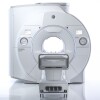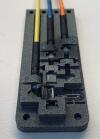Top 10 MR stories of the year
December 21, 2022
MRI

From the November 2022 issue of HealthCare Business News magazine
The year in MR news saw new heavy-duty scanners with cutting edge capabilities, as well as smaller and more portable systems bringing MR into areas it has never been before. Here, in chronological order, are the ten most-read MR stories of the year from our Daily News online.
Hong Kong scientists develop compact ultralow-field MR brain scanner
Scientists at the University of Hong Kong announced in January they had built a prototype compact ultralow-field MR scanner designed to assess brain injuries and disorders.

 The prototype is equipped with a compact two-pole 0.055T permanent samarium-cobalt (SmCo) magnet and can be plugged into a standard AC power outlet. Its dimensions are 95.2 x 70.6 x 49.7 cm, and the bore is 29 x 70 cm. Its footprint is approximately two square meters, and it is meant to be a permanent magnet-based, low-cost, low-noise, low-power and shielding-free ULF brain MR scanner, according to Physics World.
The prototype is equipped with a compact two-pole 0.055T permanent samarium-cobalt (SmCo) magnet and can be plugged into a standard AC power outlet. Its dimensions are 95.2 x 70.6 x 49.7 cm, and the bore is 29 x 70 cm. Its footprint is approximately two square meters, and it is meant to be a permanent magnet-based, low-cost, low-noise, low-power and shielding-free ULF brain MR scanner, according to Physics World.
The motivation behind the design was the fact that approximately 70% of the world’s population has little or no access to high-field superconducting MRs, which are expensive not just in cost but in installation and maintenance. The team estimates that their machine can be built in quantity with material costs under $20,000.
Additionally, roughly 30% of clinical MR cases involve the brain. This also pushed the researchers to build a ULF brain MR, because there is a great need for such imaging in the diagnosis and prognosis of various neurological diseases and injuries. "The goal is to develop methodologies for such ULF scanners to perform many routine yet clinically useful neuroimaging protocols, so as to fulfill the unmet clinical needs in point-of-care situations and/or developing countries," senior author Ed X. Wu, Lam Woo Professor in the laboratory of biomedical imaging and signal processing at Hong Kong University, told HCB News.
The findings were published in Nature Communications.
The year in MR news saw new heavy-duty scanners with cutting edge capabilities, as well as smaller and more portable systems bringing MR into areas it has never been before. Here, in chronological order, are the ten most-read MR stories of the year from our Daily News online.
Hong Kong scientists develop compact ultralow-field MR brain scanner
Scientists at the University of Hong Kong announced in January they had built a prototype compact ultralow-field MR scanner designed to assess brain injuries and disorders.
We repair MRI Coils, RF amplifiers, Gradient Amplifiers and Injectors.
MIT labs, experts in Multi-Vendor component level repair of: MRI Coils, RF amplifiers, Gradient Amplifiers Contrast Media Injectors. System repairs, sub-assembly repairs, component level repairs, refurbish/calibrate. info@mitlabsusa.com/+1 (305) 470-8013

The motivation behind the design was the fact that approximately 70% of the world’s population has little or no access to high-field superconducting MRs, which are expensive not just in cost but in installation and maintenance. The team estimates that their machine can be built in quantity with material costs under $20,000.
Additionally, roughly 30% of clinical MR cases involve the brain. This also pushed the researchers to build a ULF brain MR, because there is a great need for such imaging in the diagnosis and prognosis of various neurological diseases and injuries. "The goal is to develop methodologies for such ULF scanners to perform many routine yet clinically useful neuroimaging protocols, so as to fulfill the unmet clinical needs in point-of-care situations and/or developing countries," senior author Ed X. Wu, Lam Woo Professor in the laboratory of biomedical imaging and signal processing at Hong Kong University, told HCB News.
The findings were published in Nature Communications.
You Must Be Logged In To Post A CommentRegisterRegistration is Free and Easy. Enjoy the benefits of The World's Leading New & Used Medical Equipment Marketplace. Register Now! |
|

















Steven Ford
Possible problems with this study
March 08, 2023 12:47
The study was partially sponsored by the manufacturer of the ultra low field MRI and some of the physicians were investors in that company. This alone does not mean that the study is invalid.
The study you cite DOES NOT show that the low field MRI is nearly as effective as high field MRI in diagnosing stroke. Most importantly, the patients imaged in the ULF scanner had already been diagnosed with a stroke before imaging a second time with the low field machine. A more rigorous study would use a double-blind process.
Secondly, some of the patients were previously imaged using CT, not MRI. This is the very definition of an apples to oranges comparison.
The MRI scanner in question has limited resolution compared with virtually every MRI in the USA, even 20-year old scanners. It cannot image very small tumors or bleeds.
Finally, the study states that about 80% of the strokes were correctly identified. A more accurate headline would be 'ULF MRI leads to correct diagnosis 80% of the time' or 'ULF MRI Better Than Nothing'. More critically but more accurately, 'ULF MRI is a Poor Alternative if You Have Another Choice'.
A more meaningful study would compare low-cost CT scans to the use of this innovative and clever scanner, because they are more readily available and less costly.
This study has anecdotal value.
to rate and post a comment